engine CHEVROLET COBALT 2006 1.G Owners Manual
[x] Cancel search | Manufacturer: CHEVROLET, Model Year: 2006, Model line: COBALT, Model: CHEVROLET COBALT 2006 1.GPages: 390, PDF Size: 2.34 MB
Page 280 of 390

Notice:If the jumper cables are connected or
removed in the wrong order, electrical shorting may
occur and damage the vehicle. The repairs would
not be covered by your warranty. Always connect
and remove the jumper cables in the correct
order, making sure that the cables do not touch
each other or other metal.
A. Heavy, Unpainted Metal Engine Part or Remote
Negative (−) Terminal (GND)
B. Good Battery or Remote Positive (+) and Remote
Negative (−) Terminals
C. Dead Battery or Remote Positive (+) TerminalTo disconnect the jumper cables from both vehicles, do
the following:
1. Disconnect the black negative (−) cable from the
vehicle that had the dead battery.
2. Disconnect the black negative (−) cable from the
vehicle with the good battery.
3. Disconnect the red positive (+) cable from the
vehicle with the good battery.
4. Disconnect the red positive (+) cable from the other
vehicle.
5. Return the positive (+) terminal cover to its original
position.
Headlamp Aiming
The vehicle has a visual optical headlamp aiming
system. The aim has been preset at the factory and
should need no further adjustment
However, If the vehicle is damaged in an accident, the
headlamp aim may be affected and adjustment may
be necessary.
If oncoming vehicles �ash their high beams at you, this
may also mean the vertical aim needs to be adjusted.
It is recommended that the vehicle is taken to your
dealer for service if the headlamps need to be re-aimed.
It is possible however, to re-aim the headlamps as
described in the following procedure. Jumper Cable Removal
5-46
Page 294 of 390
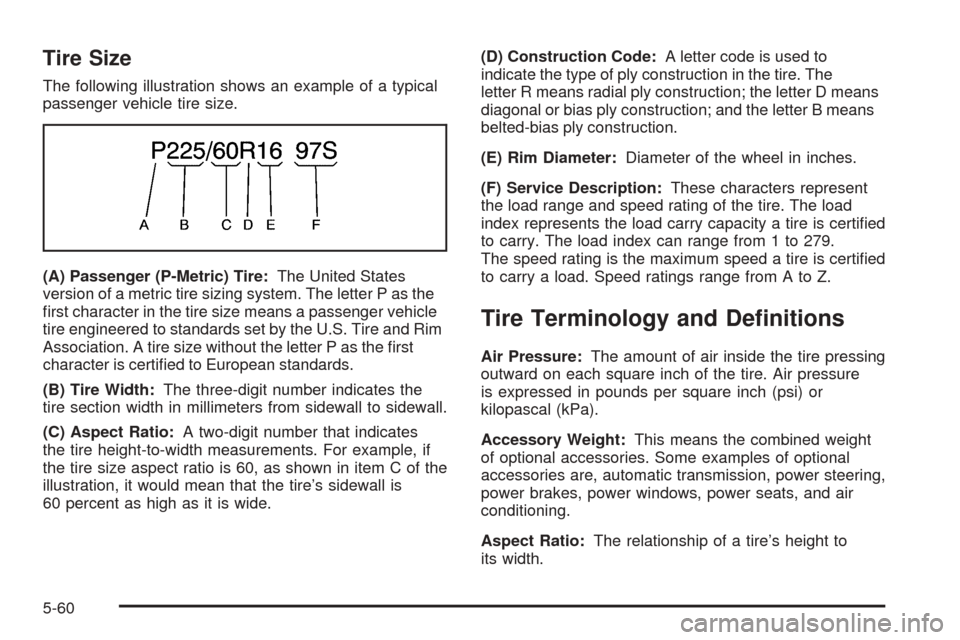
Tire Size
The following illustration shows an example of a typical
passenger vehicle tire size.
(A) Passenger (P-Metric) Tire:The United States
version of a metric tire sizing system. The letter P as the
�rst character in the tire size means a passenger vehicle
tire engineered to standards set by the U.S. Tire and Rim
Association. A tire size without the letter P as the �rst
character is certi�ed to European standards.
(B) Tire Width:The three-digit number indicates the
tire section width in millimeters from sidewall to sidewall.
(C) Aspect Ratio:A two-digit number that indicates
the tire height-to-width measurements. For example, if
the tire size aspect ratio is 60, as shown in item C of the
illustration, it would mean that the tire’s sidewall is
60 percent as high as it is wide.(D) Construction Code:A letter code is used to
indicate the type of ply construction in the tire. The
letter R means radial ply construction; the letter D means
diagonal or bias ply construction; and the letter B means
belted-bias ply construction.
(E) Rim Diameter:Diameter of the wheel in inches.
(F) Service Description:These characters represent
the load range and speed rating of the tire. The load
index represents the load carry capacity a tire is certi�ed
to carry. The load index can range from 1 to 279.
The speed rating is the maximum speed a tire is certi�ed
to carry a load. Speed ratings range from A to Z.
Tire Terminology and De�nitions
Air Pressure:The amount of air inside the tire pressing
outward on each square inch of the tire. Air pressure
is expressed in pounds per square inch (psi) or
kilopascal (kPa).
Accessory Weight:This means the combined weight
of optional accessories. Some examples of optional
accessories are, automatic transmission, power steering,
power brakes, power windows, power seats, and air
conditioning.
Aspect Ratio:The relationship of a tire’s height to
its width.
5-60
Page 308 of 390

Changing a Flat Tire
If a tire goes �at, avoid further tire and wheel damage
by driving slowly to a level place. Turn on your
hazard warning �ashers.
{CAUTION:
Changing a tire can be dangerous. The vehicle
can slip off the jack and roll over or fall on you
or other people. You and they could be badly
injured or even killed. Find a level place to
change your tire. To help prevent the vehicle
from moving:
1. Set the parking brake �rmly.
2. Put an automatic transaxle shift lever in
PARK (P), or shift a manual transaxle to
FIRST (1) or REVERSE (R).
CAUTION: (Continued)
CAUTION: (Continued)
3. Turn off the engine and do not restart
while the vehicle is raised.
4. Do not allow passengers to remain in
the vehicle.
To be even more certain the vehicle will not
move, you should put blocks at the front
andrear of the tire farthest away from the one
being changed. That would be the tire on the
other side, at the opposite end of the vehicle.
5-74
Page 331 of 390
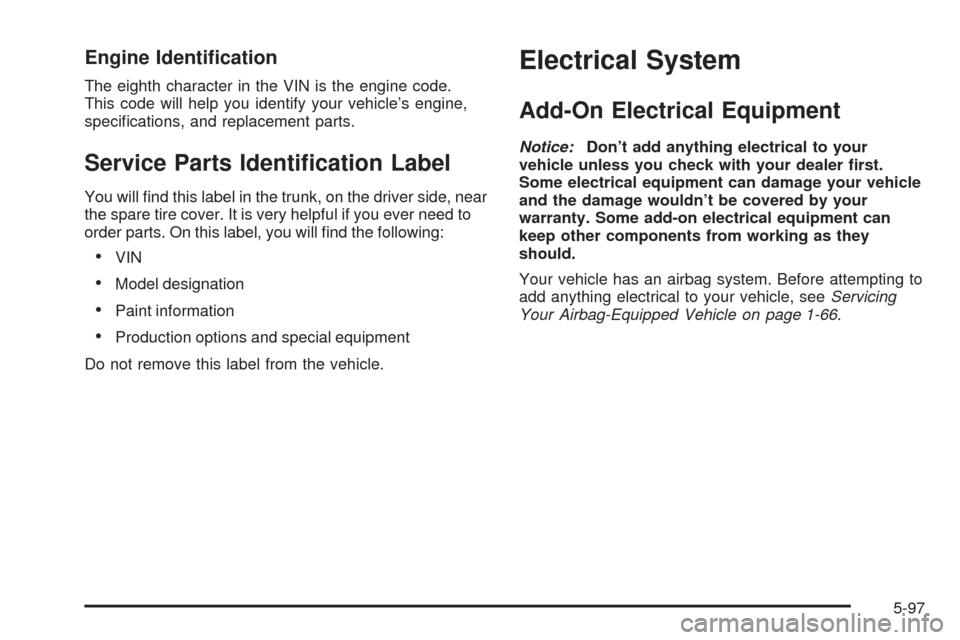
Engine Identi�cation
The eighth character in the VIN is the engine code.
This code will help you identify your vehicle’s engine,
speci�cations, and replacement parts.
Service Parts Identi�cation Label
You will �nd this label in the trunk, on the driver side, near
the spare tire cover. It is very helpful if you ever need to
order parts. On this label, you will �nd the following:
VIN
Model designation
Paint information
Production options and special equipment
Do not remove this label from the vehicle.
Electrical System
Add-On Electrical Equipment
Notice:Don’t add anything electrical to your
vehicle unless you check with your dealer �rst.
Some electrical equipment can damage your vehicle
and the damage wouldn’t be covered by your
warranty. Some add-on electrical equipment can
keep other components from working as they
should.
Your vehicle has an airbag system. Before attempting to
add anything electrical to your vehicle, seeServicing
Your Airbag-Equipped Vehicle on page 1-66.
5-97
Page 332 of 390

Headlamp Wiring
The headlamp wiring is protected by fuses. Should your
headlamps fail to function, have your headlamp
system checked right away.
Windshield Wiper Fuses
The windshield wiper motor is protected by a circuit
breaker and a fuse. If the motor overheats due to heavy
snow or ice, the wiper will stop until the motor cools.
If the overload is caused by some electrical problem,
have it �xed.
Power Windows and Other
Power Options
Fuses in the fuse block protect the power windows.
When the current load is too heavy, the fuse opens
protecting the circuit until the problem is �xed.
Fuses and Circuit Breakers
The wiring circuits in your vehicle are protected from
short circuits by a combination of fuses, circuit breakers
and fusible thermal links. This greatly reduces the
chance of damage caused by electrical problems.
Look at the silver-colored band inside the fuse. If the
band is broken or melted, replace the fuse. Be sure you
replace a bad fuse with a new one of the identical
size and rating.
If you ever have a problem on the road and do not have
a spare fuse, you can “borrow” one that has the same
amperage. Just pick some feature of your vehicle
that you can get along without — like the radio or
cigarette lighter — and use its fuse if it is the correct
amperage. Replace it as soon as you can.
There are two fuse blocks in your vehicle: the �oor
console fuse block and the engine compartment
fuse block.
5-98
Page 334 of 390

Fuses Usage
6 Ampli�er
7 Cluster
8 Ignition Switch, PASS-Key
®III+
9 Stoplamp
10Heating, Ventilation, Air
Conditioning, PASS-Key
®III+
11 Empty
12 Spare
13 Airbag
14 Spare
15 Windshield Wiper
16 Climate Control System, Cluster
17 Empty
18 Empty
19Electric Power Steering, Steering
Wheel Control
20 Sunroof
Fuses Usage
21 Spare
22 Empty
23 Audio System
24Sensing and Diagnostic Module
(Airbag)
25Engine Control Module,
Transmission Control Module
26 Door Locks
27 Interior Lights
28 Empty
29 Power Windows
Relays Usage
30 Climate Control System
31 Empty
32 Retained Accessory Power
5-100
Page 335 of 390
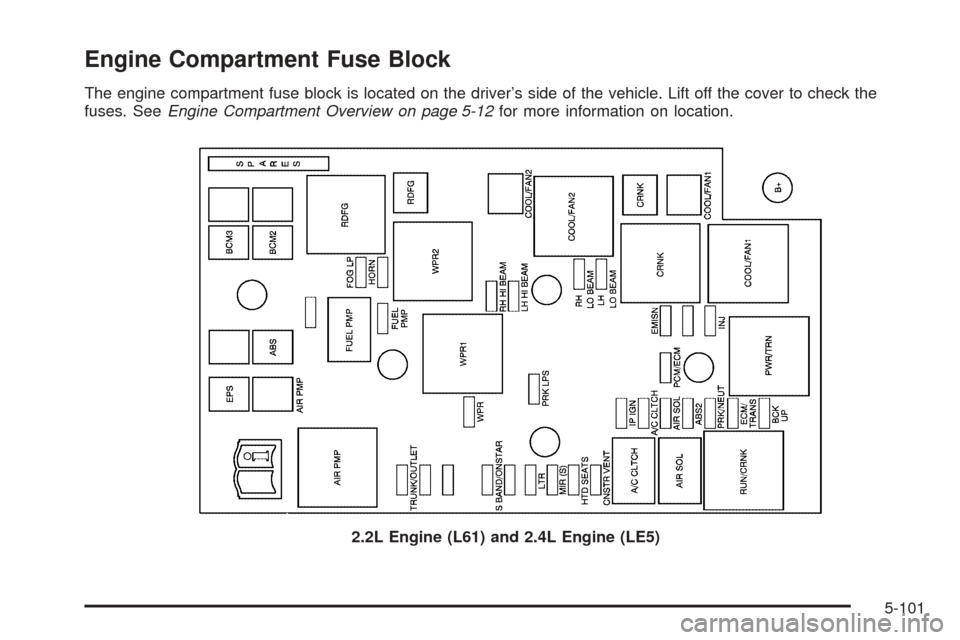
Engine Compartment Fuse Block
The engine compartment fuse block is located on the driver’s side of the vehicle. Lift off the cover to check the
fuses. SeeEngine Compartment Overview on page 5-12for more information on location.
2.2L Engine (L61) and 2.4L Engine (LE5)
5-101
Page 336 of 390

Fuses Usage
SPARES Spares
Blank Not Used
Blank Not Used
RDFG Rear Defogger
COOL/ FAN2 Cooling Fan 2
CRNK Starter
COOL/ FAN 1 Engine Cooling Fan
BCM3 Body Control Module 3
BCM2 Body Control Module 2
FOG LP Fog Lamps
HORN Horn
RH HI BEAM Passenger’s Side High Beam
LH HI BEAM Driver’s Side High Beam
RH LO BEAM Passenger’s Side Low Beam
LH LO BEAM Driver’s Side Low Beam
Blank Not Used
FUEL PMP Fuel PumpFuses Usage
EMISN Emissions
Blank Not Used
INJ Injectors
Blank Not Used
ABS Anti-lock Brake System
PCM/ECMPowertrain Control Module/Engine
Control Module
EPS Electric Power Steering
AIR PMP Air Pump
PRK LPS Park Lamps
WPR Windshield Wiper
IP IGN Ignition
A/C CLTCH Air Conditioning Clutch
AIR SOL Air Solenoid
ABS2 Anti-lock Brake System 2
PRK/NEUT Park, Neutral
ECM/TRANSEngine Control Module,
Transmission
5-102
Page 338 of 390
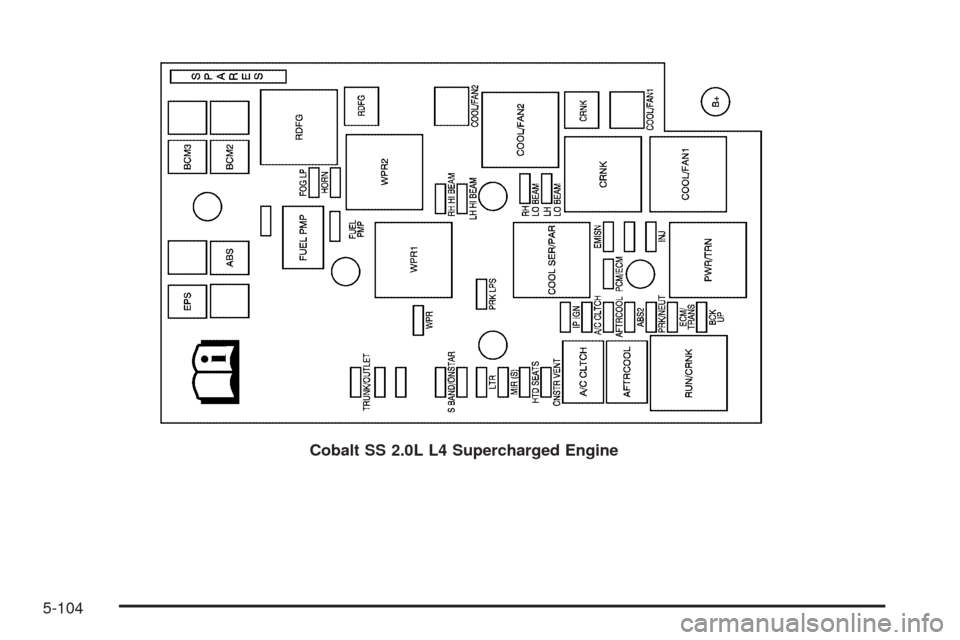
Cobalt SS 2.0L L4 Supercharged Engine
5-104
Page 339 of 390
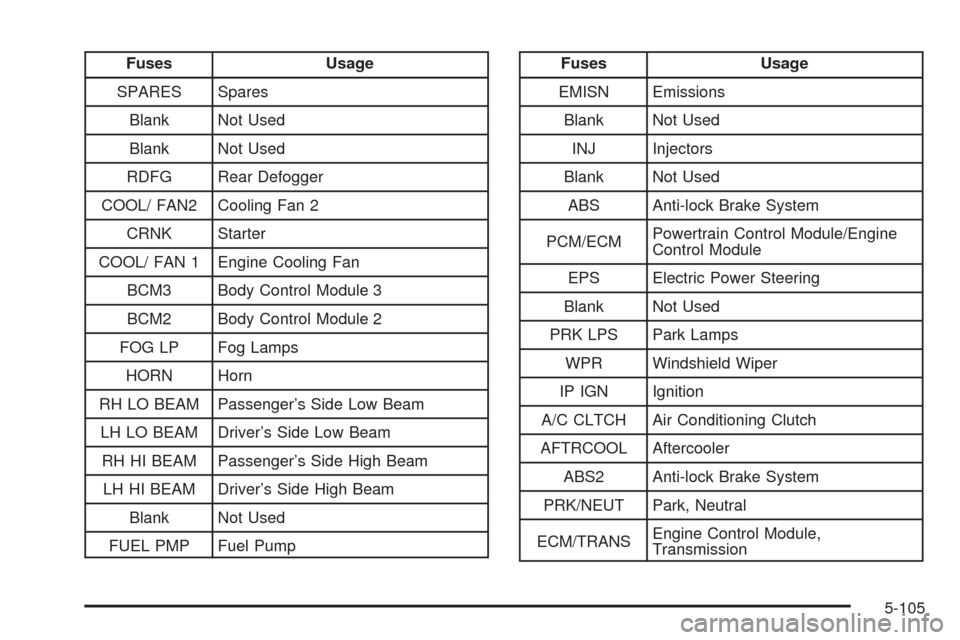
Fuses Usage
SPARES Spares
Blank Not Used
Blank Not Used
RDFG Rear Defogger
COOL/ FAN2 Cooling Fan 2
CRNK Starter
COOL/ FAN 1 Engine Cooling Fan
BCM3 Body Control Module 3
BCM2 Body Control Module 2
FOG LP Fog Lamps
HORN Horn
RH LO BEAM Passenger’s Side Low Beam
LH LO BEAM Driver’s Side Low Beam
RH HI BEAM Passenger’s Side High Beam
LH HI BEAM Driver’s Side High Beam
Blank Not Used
FUEL PMP Fuel PumpFuses Usage
EMISN Emissions
Blank Not Used
INJ Injectors
Blank Not Used
ABS Anti-lock Brake System
PCM/ECMPowertrain Control Module/Engine
Control Module
EPS Electric Power Steering
Blank Not Used
PRK LPS Park Lamps
WPR Windshield Wiper
IP IGN Ignition
A/C CLTCH Air Conditioning Clutch
AFTRCOOL Aftercooler
ABS2 Anti-lock Brake System
PRK/NEUT Park, Neutral
ECM/TRANSEngine Control Module,
Transmission
5-105